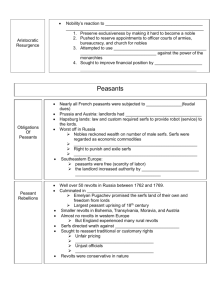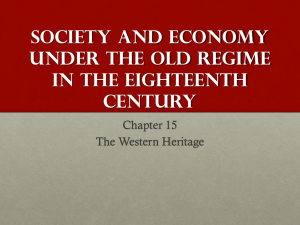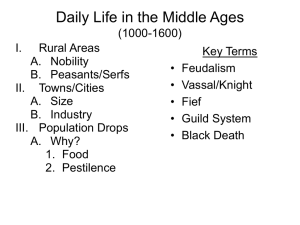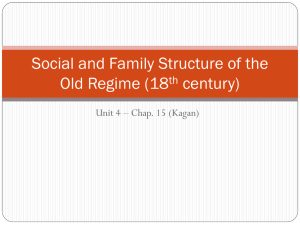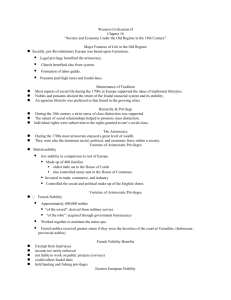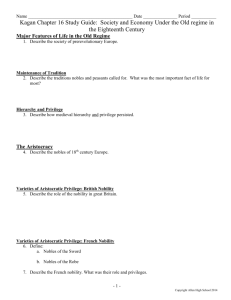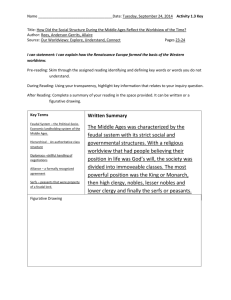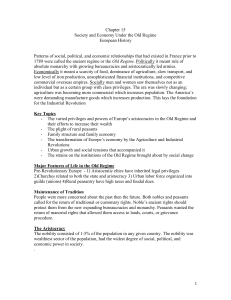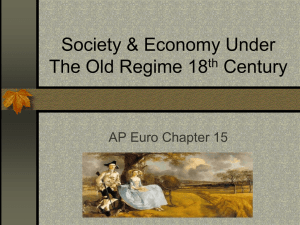Society and Economy Under the old regime in the eighteenth century
advertisement
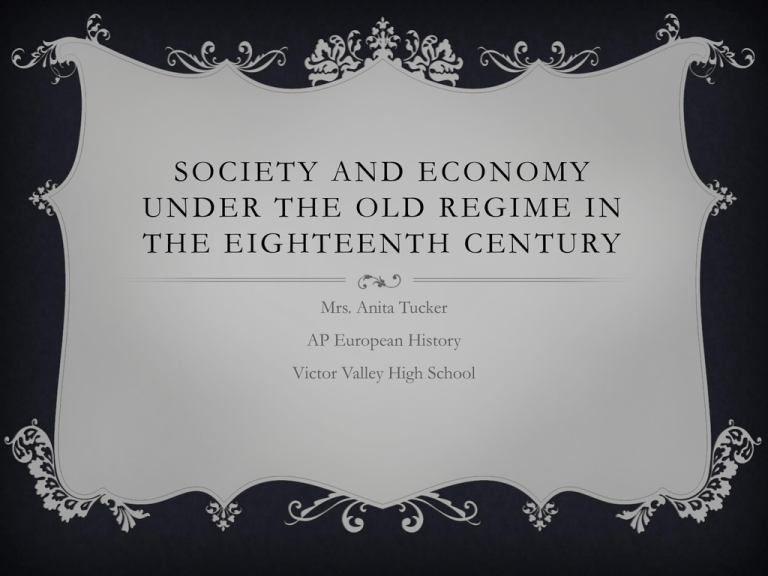
SOCIETY AND ECONOMY UNDER THE OLD REGIME IN T H E E I G H T E E N T H C E N T U RY Mrs. Anita Tucker AP European History Victor Valley High School MAIN POINTS Major Features of Life in the Ancien Regime or Old Regime The Aristocracy The Land and its Tillers Family Structures and the Family Economy The Revolution in Agriculture The Industrial Revolution of the Eighteenth Century The Growth of Cities The Jewish Population: The Age of the Ghetto ANCIEN RÉGIME Maintenance of Tradition; Hierarchy and Privilege The Aristocracy (1-5% of population) • British Nobility (400 families; eldest male of each family sat in the House of Lords; • • These families controlled many seats in the House of Commons; Owned about 1/4th of the Arable land in Britain; • French Nobility - Nobles of the Sword – through military service; Nobles of the Robe – through service or purchase; • • Did NOT pay tax (taille or land tax); responsible for vingtieme (income tax) but rarely paid it; Collected fuedal dues from tenants, enjoyed exclusive hunting and fishing privileges; ANCIEN RÉGIME Eastern European Nobilities – more complicated and repressive; military traditions of aristocracy important; • In Poland, thousands of szlachta (nobles) were exempt from taxes and held rights of life and death over their serfs. • Most nobles were not wealthy but those who did had immense estates and political power; In Austria and Hungary – nobility had large judicial powers over peasantry and had exemption from some taxation; In Prussia – after Frederick the Great in 1740, Junker noble has stronger position due to need for officers from this class for wars; Prussian nobles had extensive judicial authority over serfs; Russia – Peter the Great created Table of Ranks (1722) to establish a nobility; By 1785, Catherine the Great leally defined the rights and privileges, considerable power over serfs and exemption from taxes; ARISTOCRATIC RESURGENCE Nobility’s reaction to threat to their social position and privileges due to expanding power of the monarchies; • Exclusivity; • Reserve appoints to officer corps of military, bureaucracies, government ministries and church to Nobles; • Use authority of aristocratically institutions against power of monarchies; • Improve financial position through gaining further exemptions from taxation or collecting higher rents or long forgotten feudal dues from peasantries; OLD REGIME Before 1789 – the Ancien Regime or “Old Regime” Applies generally to life and institutions of pre- revolutionary Europe • Aristocratic elites inherited many legal privileges; • Established churches intimately related to the state and aristocracy; • An urban labor Force organized into guilds • A rural peasantry subject to high taxes and feudal dues; LAND AND ITS TILLERS Peasants and Serfs • • English and most French – Free Peasants; Serfs in Germany, Austria and Russia – legally bound to a particular plot of land and particular lord; Class that owned most of the land controlled the local government and courts; Peasants subject to feudal dues (banalités), payment to grind grain and bake bread; and forcd labor (corvée), rent for lands; In Russia, wealth was determined by the number of “souls” a noble owned; Landowners became more commercially-orientated, with growing cash crops such as cotton, potatoes, and maize, to sell at market; A scarcity of labor made peasants valuable to landowners, who regarded them as commodities rather than give them independence or legal rights; PEASANT REBELLIONS Russia – over 50 peasant revolts between 1762 – 1769, culminating wit Pugachev’s Rebellion (1773-1775) which was brutally put down; Addititional peasant revolts took place in Bohemia (1775), Transylvania (1784), Moravia (1786), Moravia (1786), and Austria (1789(. There were almost no revolts in Western Europe, although there were some rural riots against unfair pricing, changes in payment or land use; ENGLISH GAME LAWS Hunting game limited to landowners; killing a deer by nonlandowners was a capital offense. The poor would hunt in hard times, and poaching by city dwellers could be profitable; In France, during the French Revolution, penalties increased; In 1831 Parliament rewrote the game laws to allow people to hunt, ending the exclusive right of the landed gentry; FA M I LY S T R U C T U R E A N D FA M I LY E C O N O M Y Most Europeans lived in rural areas; The family was the basic unit of production and consumption in preindustrial Europe; There are two very different basic households – • Northwestern Family Model; • Eastern European Family Model; NORTH WESTERN FAMILIES Primarily consisted of a married couple, their children through early teenage years, and servants; Most households are small, between 5-6 members; No more than two generations of a family lived together; High mortality and late marriage prevented families of three or more generations (grandparents did not live with families) Nuclear family unit rather than extended family unit; Neolacalism – men usually were over twenty-six and women over twenty-three when they married; Many would hire themselves as servants for 8 years to save money for marriage; E A S T E R N E U RO P E A N FA M I L I E S Both men and women usually married before the age of twenty; Children were born to much younger parents; Rural Russian households were more than nine and sometimes more than twenty members with three or four generations living together; Multi-generational households were encouraged by landowners to ensure they could have enough to cultivate the crops; marriage between neighboring serfs or free workers was discouraged; FAMILY ECONOMY Most people worked within the family economy; Most people lived in a family our household – beggars and those living independently were viewed with hostility and considered criminals; The death of the father could easily spell disaster for the family, especially in western Europe. Women's economic contributions to the household were considered more important than their biological reproductive capacities. Women and babies experienced high mortality rates during and after childbirth; and many infants were abandoned, usually for economic reasons. AG R I C U LT U R A L R E VO LU T I O N Population exploded starting in the 18th century. Europe's population in 1850 was probably between 100 and 120 million people; by 1800 there were almost 190 million Europeans, and by 1850 there were 260 million. Historians have proposed, and subsequently discarded, various explanations for this population growth. One factor was the introduction, from America, of the highly productive food crop, the potato. Increasing population led to increasing demand, and therefore increasing prices, for wheat and bread. AG R I C U LT U R A L R E VO L U T I O N This hurt peasants, but helped larger landowners. Landlords began to treat crop cultivation as a commercial operation, and introduced new techniques that increased crop yields. The economic and social organization of farming also changed: in England, for example, the enclosure movement rationalized the use of land and allowed higher productivity – though it also caused serious problems for peasants and poor villagers. Governments sided with landowners, however, and peasant revolts were suppressed. In eastern Europe, land ownership patterns and social structures were less encouraging of agricultural innovation. THE INDUSTRIAL REVOLUTION O F T H E 1 8 TH C E N T U RY The Industrial Revolution was about economic growth and new patterns of consumption, as much as it was about technological and organizational innovations in industry. Europe's traditional economy of scarcity was replaced by a demanddriven cycle of growth. Advertising and social emulation fueled consumer demand, especially in Great Britain, where political and economic factors were also favorable for innovation. THE INDUSTRIAL REVOLUTION O F T H E 1 8 TH C E N T U RY The domestic system of textile production was the first area of industry to be transformed, through the introduction of Hargreaves' spinning jenny around 1765, Arkwright's water frame in 1769, and Cartwright's power loom in the late 1780s. Watt's 1769 steam engine, based on Newcomen's work more than 50 years earlier, was applied to industries ranging from mining to textiles to, eventually, transportation. Iron became the backbone of industrial machinery. As work was re-organized to accommodate the new machines, labor was increasingly segregated by gender, and women's work was systematically de-valued. THE GROWTH OF CITIES Cities grew substantially between 1500 and 1800, but which cities grew and in which ways cities changed were markedly different. Between 1600 and 1750, capital cities and ports grew most vigorously, while smaller cities in general actually lost population. After 1750, smaller cities began to grow more rapidly than larger ones, and entirely new cities emerged, especially around factories. City-dwellers led radically different lives, depending on their social class. THE GROWTH OF CITIES The upper classes lived quite comfortably, and often controlled city government. The middle class was the most dynamic group, with aspirations and fears led them to support reform, change, and economic growth. Artisans, who made up the largest group, were generally conservative. Bread riots were sparked by artisans who believed merchants were not charging economically "just" prices, while other forms of riots could be fueled by religious prejudice or political agendas. TH E J E W I S H P O P U L ATI O N – T H E AG E O F T H E G H E T T O Jews were segregated and discriminated against on religious grounds throughout Europe. The vast majority of Jews lived in eastern Europe, particularly Poland, Lithunia, and the Ukraine. In most countries Jews were treated as resident aliens, without political or civil rights and socially inferior; only in England was it possible for Jews to mingle with mainstream society. TH E J E W I S H P O P U L ATI O N – T H E AG E O F T H E G H E T T O This was the age of the ghetto, or separate community, either distinct districts within cities or separate, Jewish villages in rural areas. Most Jews were poor; one exceptional category was the so-called "court Jews," who helped finance royal projects (usually wars). Jews, especially children, were sometime forcibly converted to Christianity, and they were sometimes killed for their religious beliefs. CONCLUSION Europe's traditional, corporate society was transformed by several processes that began in the 18th century. Increasing population meant that wheat and bread prices rose, allowing large landowners to accumulate capital. They invested in innovations that fueled the Agricultural Revolution. The Industrial Revolution was driven by demand for the consumption of goods, particularly by the middle class. Women's work was devalued. Commercialism and market values gained prominence. The monarchy, nobility, and middle class all jockeyed for power and prestige; this creative tension fostered further innovation.
